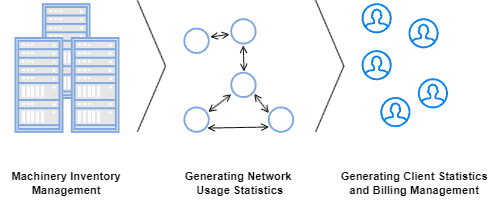1. 引言
在本教程中,我们将深入探讨 FCAPS 网络管理模型。现代网络高度互联,众多服务都依赖于其正常运行。因此,网络管理员和运维人员必须从多个维度确保网络的可用性与服务质量。
FCAPS 是一个经典的网络管理模型,它定义了五个关键管理层面:故障管理(Fault)、配置管理(Configuration)、计费管理(Accounting)、性能管理(Performance)和安全管理(Security)。每个层面都对应了特定的管理职责和流程。
接下来,我们会先了解网络管理的基本概念,然后逐一解析 FCAPS 的五个管理层次,最后进行系统性总结。
2. 网络管理概述
网络管理,简而言之,是指为确保网络稳定、高效运行而执行的一系列操作流程。所谓“稳定运行”,意味着网络能够在既定性能指标(如最大延迟、最小吞吐量)下正常传输数据。
FCAPS 模型由国际标准化组织 ISO 在上世纪 80 年代初提出,旨在为网络管理解决方案和框架的开发提供统一指导。该模型将网络管理划分为五个层级,分别对应不同的管理目标与操作流程。
一些基于 FCAPS 模型构建的网络管理协议和框架包括:
- TMN(电信网络管理):一种通用的网络管理架构,包含四个管理层(设备层、网络层、服务层、业务层),每层均涵盖 FCAPS 的全部五个管理层面
- CMIP(公共管理信息协议):基于被管理对象的模型,允许服务提供商控制网络,涵盖 FCAPS 所有五个管理层面
- CMIS(公共管理信息服务):用于定义 CMIP 对象的服务接口,自然也涵盖 FCAPS 的所有管理层面
接下来,我们将逐一解析 FCAPS 的五个管理层面。
3. FCAPS 模型详解
FCAPS 模型从整体角度出发,提出了五个网络管理层面,分别对应不同的管理职责与操作流程。
3.1 故障管理(Fault Management)
网络中出现故障是不可避免的,即使采取了多种预防措施。因此,故障管理的目标是及时发现故障、减轻其影响并恢复系统正常运行。
FCAPS 提出了一个五步循环流程来处理故障:

- 检测(Detection):识别系统中是否发生异常
- 诊断与隔离(Diagnosis/Isolation):定位受影响的部分
- 关联与聚合(Correlation/Aggregation):评估故障的潜在影响和后果
- 恢复(Restoration):开始修复工作,使系统恢复基本功能
- 解决(Resolution):确认故障已彻底解决
✅ 踩坑提醒:如果故障检测机制不完善,可能导致问题长期未被发现,影响用户体验。
3.2 配置管理(Configuration Management)
配置管理的核心在于确保网络系统在其生命周期内始终按照预期运行,即使经历了更新、升级或扩容。
它涵盖了硬件与软件两方面的管理:

硬件管理:
- 设备清单管理(Inventory Management)
- 资源分配优化(Allocation Management)
- 硬件扩容与升级(Upgrading and Scaling Management)
软件管理:
- 选择合适的硬件运行软件
- 软件版本控制与更新
- 系统权限配置
✅ 踩坑提醒:配置变更未记录或版本混乱,容易导致系统不可用。
3.3 计费管理(Accounting Management)
计费管理的目标是优化网络资源在客户端之间的分配,通常涉及网络管理员、运维人员与客户端之间的协作。
它包括以下关键任务:

- 维护网络资源清单(Inventory Management)
- 生成客户端使用统计报表(Usage Statistics)
- 客户权限与访问控制管理
- 费用计算与账单生成(Billing)
⚠️ 注意:计费管理不仅限于收费,还包括资源使用情况的监控与优化。
3.4 性能管理(Performance Management)
顾名思义,性能管理的目标是监控并提升网络整体性能,如最大化吞吐量、最小化延迟、避免瓶颈等。
常见性能管理任务包括:

- 监控服务器负载(Machine Overload Monitoring)
- 收集网络指标(Network Metrics Collection)
- 服务质量(QoS)监测
- 运行性能优化算法(Optimization Algorithms)
✅ 踩坑提醒:忽视性能监控可能导致服务降级或 SLA 违约。
3.5 安全管理(Security Management)
安全管理的核心在于控制对网络资源的访问,防止非法访问与攻击。
典型的安全威胁包括:
- 拒绝服务攻击(DoS/DDoS)
- 中间人攻击(MITM)
- DNS 污染(DNS Poisoning)
常见的安全措施包括:
- 部署入侵检测与防御系统(IDS/IPS)
- 使用防火墙(Firewall)
- 安装杀毒软件(Antivirus)
- 加密敏感数据(Encryption)

✅ 踩坑提醒:忽视安全策略可能导致数据泄露或服务中断。
4. 系统性总结
| 管理层级 | 简要定义 | 主要实践 |
|---|---|---|
| Fault | 识别并处理网络故障,减轻影响 | 检测、诊断/隔离、关联/聚合、恢复、解决 |
| Configuration | 确保系统在其生命周期内正常运行 | 设备清单更新、设备配置、软件部署与更新 |
| Accounting | 优化资源分配与管理 | 资源清单管理、使用统计、计费 |
| Performance | 提升网络与服务性能 | 负载监控、网络指标监控、QoS 监控、优化算法 |
| Security | 控制资源访问,防范攻击 | 流量分析、进程监控、服务可用性保障、数据加密 |
5. 结论
通过本教程,我们深入了解了 FCAPS 模型的五个管理层面。网络管理是一项复杂而关键的任务,尤其在现代服务依赖网络的背景下,FCAPS 提供了一个系统化的框架来指导网络运维工作。
✅ 采用 FCAPS 模型有助于提升网络的可维护性与服务质量,是网络管理实践中值得借鉴的重要模型。